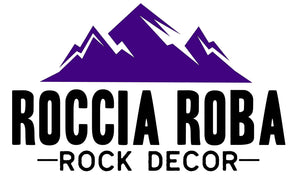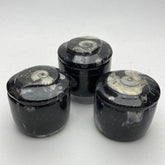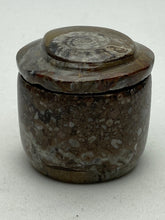Everything You Want to Know About Amethyst Crystal
Amethyst is a member of the quartz mineral family that is distinguishable by its purple color.
Historically, this gemstone was reserved for royalty, but today it is used widely as home and office décor and jewelry for everyone. Our Amethyst Geode Lamps are the perfect example; these are beautifully made from Uruguayan amethyst clusters or Moroccan amethyst slabs and hold one or more candle wicks that reflect off of the crystals underneath.
Amethyst is the birthstone for Pisces and the month of February, the gemstone for the 6th and 33rd anniversaries of marriage, and a very important and powerful metaphysical and healing semi-precious gem.

Geology: From Lava Rocks to Purple Crystals
Amethyst is simply a variety of quartz. As such, its chemical makeup is composed of silicon dioxide. They typically form in the remnants of gas bubbles trapped in lava flows that left hollow cavities or fissures where the igneous or metamorphic rock split over time. The cavities and fissures would then be filled with silica-rich liquid allowing the crystals to form inside these cavities.
Since Amethyst is a form of quartz, the physical properties are almost identical to other color varieties. Amethyst receives its purple color during crystal growth when trace amounts of iron are incorporated into a growing quartz crystal. After crystallization, gamma rays, emitted by radioactive materials within the rock in which it was formed, irradiate the iron creating the purple color.
Geography: Where does Amethyst Come From?
Amethyst is generally found all over the world. But since Amethysts are formed in the gas pockets and fissures in former lava flows, most of the world’s important amethyst deposits are usually found in the locale of igneous rocks. Brazil and Uruguay host large amounts of amethyst in the cavities of basalt flows.
Other productive amethyst deposits are found in Canada, France, India, Madagascar, Mexico, Morocco, Myanmar, Namibia, Russia, South Africa, Sri Lanka, Tanzania, and the United States.
At Roccia Roba, we are pleased to be able to source material for our Amethysts for home and office décor from many locales, including Uruguay, Brazil, Morocco, Madagascar, and the United States (Colorado). Most of the Amethyst Geode Lamps in our store are made with vertically cut Amethyst clusters from Uruguay. However, check out the difference between the Moroccan amethyst oil lamp and the Uruguayan amethyst oil lamp; both are stunning and provide a different texture.

Moroccan Amethyst Geode Lamp

Uruguay Amethyst Geode Lamp
History: A Tale of Greek Mythology and Catholic Priest
According to Greek mythology, Amethyst was a young virgin who became the object of wrath of the Greek God Dionysus after he became intoxicated with red wine. When Amethyst cried out to Goddess Diana for help, she immediately turned the girl into white, shimmering quartz. When Dionysus realized what had happened and felt remorse for his actions, his tears dripped into his goblet of red wine. The goblet overturned, and the red wine spilled all over the white rock, saturating it until it became the purple quartz that is now known as Amethyst.

How did Amethyst really get its name? Amethyst actually derives from the Greek "amethystos", a reference to the belief that the stone protected its owner from drunkenness. The ancient Greeks wore amethyst and made drinking vessels decorated with it in the belief that it would prevent intoxication.
During the Middle Ages, Amethyst stood for piety and celibacy and was therefore worn by members of the Catholic Church clergy and was used to adorn crosses. St. Valentine was thought to wear a ring set with an antique Amethyst carved with an image of Cupid.
During the Renaissance, Amethyst represented humility and modesty. Monarchs used Amethyst as a symbol of royalty. In fact, they were used to decorate the British Crown Jewels.
Throughout history, the value of Amethyst rivaled that of a diamond. Until the discovery of vast deposits during the 18th century in South America. Since then, the once precious stone has lost much of its value.
Metaphysical: What is Amethyst Stone good for? What is the spiritual meaning of Amethyst?
Disclaimer: Crystals can complement other therapies and support overall well-being. However, crystals should not be used as a replacement for medical treatment. The information contained herein is metaphysical in nature and does not claim to heal or cure, and should not be considered as a substitute for conventional medicine.
Please note, the following is not intended to provide any specific health or well-being advice and is intended as a guide only. For medical advice, please consult a licensed healthcare professional.
Amethyst is a powerful and protective crystal and is the first choice of many metaphysicians and crystal lovers. It forms in points, geodes, or cathedrals that are often cut and polished into various shapes as well as tumbled smooth.
A natural stress reliever, Amethyst encourages and supports inner strength. Placing an amethyst geode lamp next to your bed or bath will help support you as you try to relax.
It is also thought that Amethyst connects the physical plane with the higher realm, making it a good choice when working with the Third Eye Chakra. Amethyst also provides peaceful energy for meditations and may help with the development of intuitive and psychic abilities.
Amethyst opens and activates the Crown Chakra, allowing easier access to the divine. Amethyst enhances spiritual awareness and spiritual wisdom, promoting a higher state of consciousness. Amethyst clears and repairs holes in the aura. It draws Divine energy and aligns and fosters cooperation between the energy bodies.
Physically, Amethyst may help alleviate headaches or migraines, dispel nightmares, and help with insomnia. Amethyst may also reduce eyestrain, especially when working at a computer.

How we use Amethyst in our home and office décor
We like amethyst for a lot of reasons; in fact, the purple you see in our logo or in our booth decor at various pop-up shows we participate in around the Colorado and Wyoming Rocky Mountains.
As you can see from our online shop, we offer amethysts in many different forms – sometimes, in the form we receive them directly from the miners from around the globe. In other cases, we use Amethyst as a foundational stone used in our hand-crafted home and office décor items – oil candles (amethyst geode lamps), candle holders, air plant holders, business card holders, cell phone stands, cabinet knobs, and more!

How We Cut the Amethyst Clusters
Amethyst rates as a 7 on the Mohs hardness scale. Because of this high hardness, it is not easy to work with conventional tools. Therefore, we have spent a great deal of time learning the proper techniques for using diamond-crusted, water-cooled tools to shape the Amethysts forms we require to produce our Amethyst-based rock décor.
IMPORTANT CARE TIP: Amethyst specimens from certain localities are known to fade upon prolonged exposure to sunlight. We strongly suggest that Amethyst be kept out of the direct sunlight to preserve its great purple color.







1 comment
I love Amethyst! Besides size, are there any differences between small/larger size formations within a single piece? Thanks